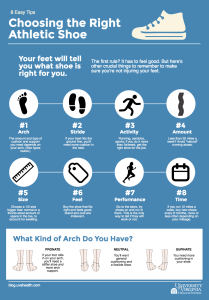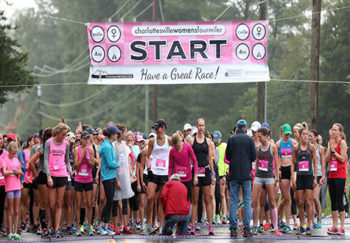Choosing a running shoe? The shoe you choose really does matter.

This fact was confirmed for me by Venkat Perumal, MD, orthopedic foot specialist at UVA.
I had had my doubts. Recently, I tried to buy running shoes. I grew overwhelmed wandering around the mounds of electric neon athletic shoes, trying to figure out if I needed a cross-trainer or an aerobic shoe, wondering if I needed a thin sole or a cushy one.
What kind of shoe did I need? How could I tell? Did price or brand matter? Did it matter what kind of shoe I picked at all?
Yes, says Perumal. “Whether you’re just starting to run or do 20 miles a week, it matters. Every foot is different. One shoe does not fit all.”
Choosing a Running Shoe: What to Consider
Here are key things to take into account when choosing a running shoe.
Your Arch
What kind of arch do you have in your foot? Perumal says this is one of the main things to consider when choosing a shoe.
People have one of three types of foot arches:
- Neutral – normal
- Pronation – your arch caves in towards your inner foot
- Supination – your arch turns out to the outside of your foot
If you have a neutral arch, you’ll want general cushioning, arch support and a flexible shoe.
If your foot pronates, you’ll need a stiffer shoe to hold your foot in place, along with more arch support.
Supinators need more cushioning in the shoe.
Your Stride
It’s helpful to know your running style when shopping for athletic shoes.
When you run, does your heel come down first? Or your toe? Or does your whole foot land on the ground all at once? Where you land could use more cushion.
If you land on your heel first, you’ll want a small heel-to-toe drop.
The Type & Location of Your Activity
What are you doing? Running, hiking, cross-training, tennis, walking — believe it or not, different activities strain different parts of your feet. Finding the shoe that best supports your activity makes a difference in the long run.
Along with what you’re doing, you’ll need to pay attention to the type of floor where the activity happens. A hard tennis court, a gravel track, a carpet, a wooden gym —don’t overlook the impact of the surface where you’re active.
However, unless you perform an activity more than three times a week, you don’t need to buy a different shoe for each activity.
How Much You Run (Is Barefoot Running OK?)
When it comes to determining the amount and location of cushion you need in your shoe, consider the amount of activity you’re doing.
Less than 20 miles a week? Perumal does not recommend “natural” running shoes that offer barely any cushion at all. “Your feet will be slapping down to the floor, causing shock and pressure to your joints, bones and tendons,” he says.
More than 20 miles a week? “Your foot will get used to less cushion,” Perumal says, so five-fingers shoes or even barefoot running are not risky options — though you’ll want to run on better surfaces.
But no matter how many miles a week you run, what matters most is what feels good to you. “Do you want to feel your foot or run in a cloud?” he asks. “Choose what feels good to you.”
Your best bet? Get evaluated at a specialty athletic or running shoe store.
Shopping Guidelines: Rules to Run By
Get the Right Size
“Make sure you have adequate space in the shoe for your foot to expand in the front, about one-third of an inch. Your feet swell when you run, so go half a size bigger than normal,” Perumal says.
Renew the Shoe
Rule of thumb (or toe): Change your shoes every 3-4 months. Keep track of your miles (you should be good for six months at 12 miles a week), and notice when running starts to hurt. “You can’t tell from the outside of the shoe that the conditioning is gone,” Perumal notes.
Never Mind the Price
“More expensive doesn’t equal a better shoe.”
Be Brand Blind
“Brand doesn’t matter.”
Change With Age
Just because a shoe works at one point in your life doesn’t mean it always will. “As you grow older, your feet change,” Perumal says. “Your joints change from all those forces going through the foot over time — the alignment changes, joints loosen, you have more pressure through the foot.”
Visit the Runner’s Clinic
Whether just starting or a pro, we can help you stay safe and healthy while you train at the Runner’s Clinic.
Try Before You Buy
Even if you want to find the best deal online, first visit a store in person. Have a shoe expert evaluate your foot, try the shoes on and then actually run in the store.
If you have orthotics or inserts, make you sure you bring those with you, as they change everything about the way a shoe fits.
This is Perumal’s #1 rule. “Your feet will tell you what shoe is right for you.”
Pain is Not a Gain
Your feet shouldn’t hurt. Foot injuries are fairly common. If you have a minor sprain, take it easy, use a brace or bandage. Swollen? Give it 2-3 weeks, let your ligament heal and get back to exercise slowly. If rest doesn’t help, see your doctor.


The best shoes are the ones that make the exerciser comfortable. Walking or running in uncomfortable shoes can lead to injury. It is also difficult to find motivation to exercise if you know that you ll be uncomfortable. It may take a few tries to find the right shoes for your feet, but having shoes that fit properly and feel good on your feet is worth the hassle.